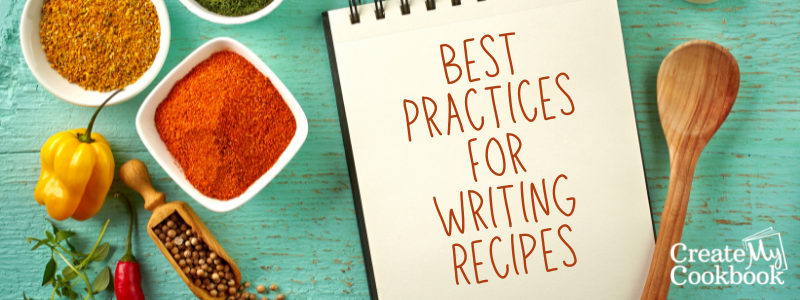Best Practices for Writing Recipes
Guest Blogger - Jun 22, '21 - Cookbook Ideas - OrganizationTake your recipe writing to the next level with these helpful tips
One of the most valuable skills I’ve learned as a chef and professional recipe developer, besides learning proper cooking techniques, is the art of crafting a recipe. It’s one thing to know how to combine ingredients and transform them into something special, and something entirely different to know how to translate that into a recipe that’s easy to follow.
Doesn’t that just mean you know how to list ingredients and directions on how to prepare them? Sure, you may know the recipe inside out and be able to cook it in your sleep without breaking a sweat. Yet there are some best practices and little nuances that have the potential to make the process so much easier. Here are a few tips to make recipe writing not only simpler but more efficient as well.
Write out the direction steps first.
I know the ingredients are always listed first, so it seems to make more sense to list the ingredients first. Why would you write the steps down first? By listing the direction steps first, it forces you to think about the cooking process, will make listing the ingredients much easier, and will help reduce the likelihood that you miss using all of the ingredients in your directions. Bonus tip: If you have time, try making the recipe using the directions and ingredients you’ve listed. Does it make sense and flow logically? Now would probably be a good time for revisions.
Next, list the ingredients in the order you use them in the recipe.
Sounds logical, right? By listing the ingredients in the order you use them, you’re also likely to reduce the possibility of forgetting something. It also reenforces and confirms that your direction steps are correct. I can’t tell you how many times in the past (before I finally stopped doing it the hard way) I’ve written recipes listing the ingredients first, only to forget a step or omit how to use an ingredient in the directions.
True story. I was preparing a meal for one of my former clients, who was following a very strict meal plan provided by the weight loss spa they had previously visited. I was to carefully follow the recipe. It listed the ingredients for a delicious marinated tenderloin steak. When I got to the direction steps, it meticulously laid out the method for mixing up the marinade and marinating the steak for 30 minutes. The end.
If that had been my first time in the kitchen, I would have asked “now what do I do with the marinated steak?” Eat it raw like steak tar-tar? Boil it? Chop it up and make tacos? Okay, that one sounds pretty good. As a seasoned cook you may laugh but not everyone would intuitively know to grill or broil the steak before serving it. Please never take for granted that everyone would know what to do next.
Write your recipe in clear, concise language
You’re the expert on your recipe. Keep in mind, however, that a good recipe should be easy to follow and that it should be clear enough that a novice cook could pick it up and be able to produce the same beautiful dish you’ve been creating for years. If you’re using a culinary term such as “concasse” or “blanch” or “chiffonade”, be sure to explain what that is in the recipe notes or in the direction steps.
Be specific with measurements.
A handful or a pinch of something to one person may be much larger or smaller than for someone else and could result in a dish that is, well, unfortunate. Are you using a can of tomato sauce or beans? What size can? No I don’t mean large vs small - be specific….how many ounces? As someone who loves the concept of freestyle cooking, this one remains the most difficult discipline for me to practice.
Consistency with measurement terms is essential.
Do you prefer using the abbreviation for teaspoon (t. or tsp) versus spelling it out? Go for it, but be consistent about it and use the same spelling or abbreviation throughout the entire recipe. Tsp (teaspoon) and Tbs (Tablespoon) are very similar and can be easily mistaken for one or the other and a simple typo mixing what was intended to be a teaspoon of salt and accidentally spelling it Tbsp would not end well. I speak from experience here.
Finally, make it personal.
Recipes are a way of passing down traditions from one generation to the next, sharing experiences and bringing people together. If you have a funny story that goes along with a recipe, or memories of the inspiration behind a particular dish, by all means share it! It’s a sure-fire way to connect with people and lets them get to know the person and story behind the recipe in a more personal, perhaps relatable, way. It has the potential to bring families and communities together. That’s powerful stuff!
Now that you’re equipped with some tested recipe creation steps, how about it? Are you ready to share those treasured family recipes in a cookbook of your own? Let us know some of your tried and true recipe best practices!
Next: 5 Benefits of CreateMyCookbook's WeReviewIt Service



